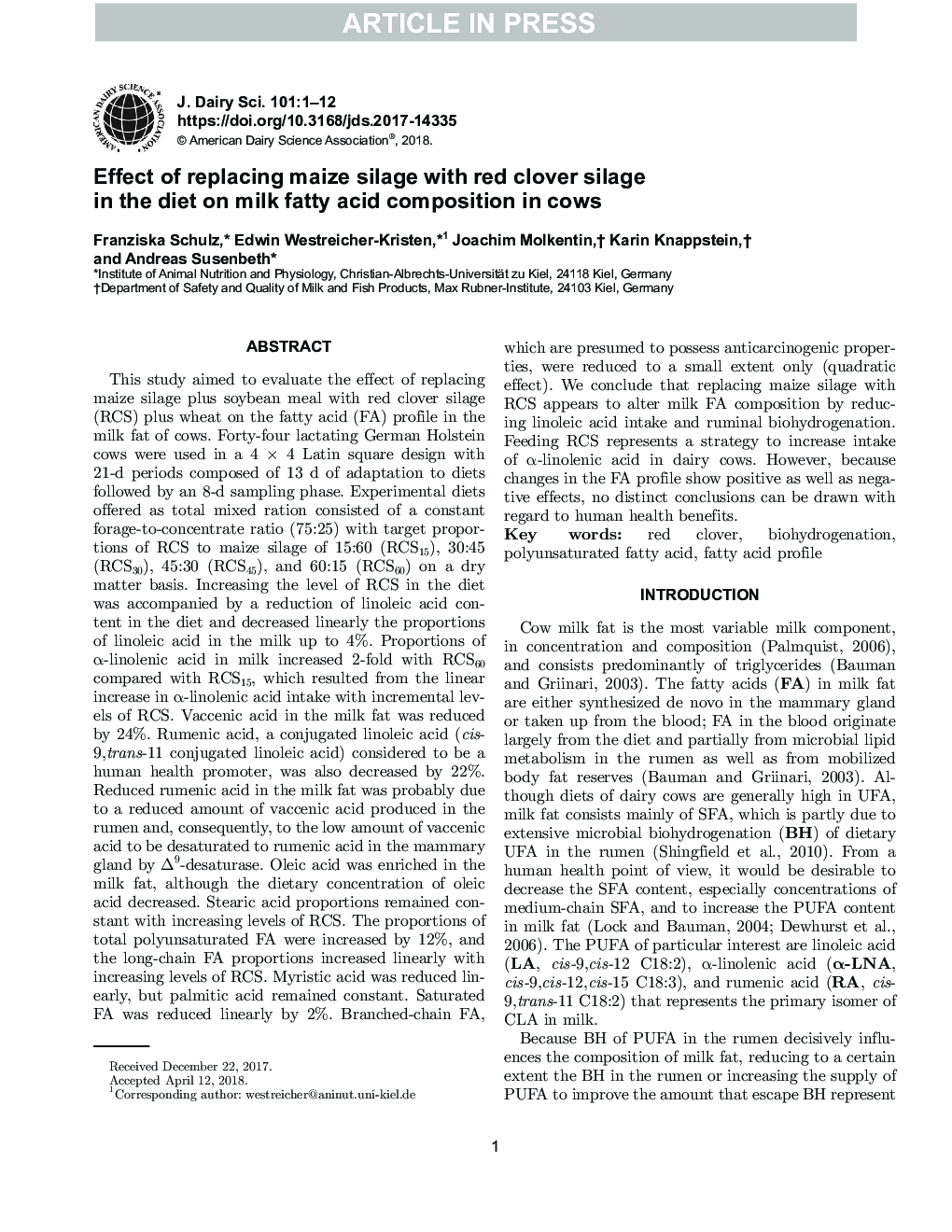| کد مقاله | کد نشریه | سال انتشار | مقاله انگلیسی | نسخه تمام متن |
|---|---|---|---|---|
| 8500895 | 1553837 | 2018 | 12 صفحه PDF | دانلود رایگان |
عنوان انگلیسی مقاله ISI
Effect of replacing maize silage with red clover silage in the diet on milk fatty acid composition in cows
ترجمه فارسی عنوان
اثر جایگزینی سیلاژ ذرت با سیلاژ شبدر قرمز در رژیم غذایی بر ترکیب اسید چرب شیر در گاوها
دانلود مقاله + سفارش ترجمه
دانلود مقاله ISI انگلیسی
رایگان برای ایرانیان
کلمات کلیدی
شبدر قرمز، بیو هیدروژناسیون، اسید چرب اشباع نشده، مشخصات اسید چرب،
موضوعات مرتبط
علوم زیستی و بیوفناوری
علوم کشاورزی و بیولوژیک
علوم دامی و جانورشناسی
چکیده انگلیسی
This study aimed to evaluate the effect of replacing maize silage plus soybean meal with red clover silage (RCS) plus wheat on the fatty acid (FA) profile in the milk fat of cows. Forty-four lactating German Holstein cows were used in a 4 à 4 Latin square design with 21-d periods composed of 13 d of adaptation to diets followed by an 8-d sampling phase. Experimental diets offered as total mixed ration consisted of a constant forage-to-concentrate ratio (75:25) with target proportions of RCS to maize silage of 15:60 (RCS15), 30:45 (RCS30), 45:30 (RCS45), and 60:15 (RCS60) on a dry matter basis. Increasing the level of RCS in the diet was accompanied by a reduction of linoleic acid content in the diet and decreased linearly the proportions of linoleic acid in the milk up to 4%. Proportions of α-linolenic acid in milk increased 2-fold with RCS60 compared with RCS15, which resulted from the linear increase in α-linolenic acid intake with incremental levels of RCS. Vaccenic acid in the milk fat was reduced by 24%. Rumenic acid, a conjugated linoleic acid (cis-9,trans-11 conjugated linoleic acid) considered to be a human health promoter, was also decreased by 22%. Reduced rumenic acid in the milk fat was probably due to a reduced amount of vaccenic acid produced in the rumen and, consequently, to the low amount of vaccenic acid to be desaturated to rumenic acid in the mammary gland by Î9-desaturase. Oleic acid was enriched in the milk fat, although the dietary concentration of oleic acid decreased. Stearic acid proportions remained constant with increasing levels of RCS. The proportions of total polyunsaturated FA were increased by 12%, and the long-chain FA proportions increased linearly with increasing levels of RCS. Myristic acid was reduced linearly, but palmitic acid remained constant. Saturated FA was reduced linearly by 2%. Branched-chain FA, which are presumed to possess anticarcinogenic properties, were reduced to a small extent only (quadratic effect). We conclude that replacing maize silage with RCS appears to alter milk FA composition by reducing linoleic acid intake and ruminal biohydrogenation. Feeding RCS represents a strategy to increase intake of α-linolenic acid in dairy cows. However, because changes in the FA profile show positive as well as negative effects, no distinct conclusions can be drawn with regard to human health benefits.
ناشر
Database: Elsevier - ScienceDirect (ساینس دایرکت)
Journal: Journal of Dairy Science - Volume 101, Issue 8, August 2018, Pages 7156-7167
Journal: Journal of Dairy Science - Volume 101, Issue 8, August 2018, Pages 7156-7167
نویسندگان
Franziska Schulz, Edwin Westreicher-Kristen, Joachim Molkentin, Karin Knappstein, Andreas Susenbeth,
